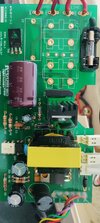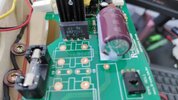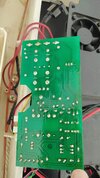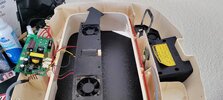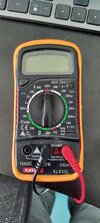tonywolfin
New Member
Hello, first time post here and not much electronics knowledge, but a willing spirit! I am trying to repair my failed RCOM PX20 Digital egg incubator. It's quite an old model however I do like how it works.
I was using it until couple of day ago, it was on and working properly, then i unplugged it to move it and when I plugged it back, it did a small noise and won't start anymore.
I did the following tests with a multimeter :
1- I tested the input when plugged at the CN1 and CN2 connections and it has 236V (France)
2- I did a continuity beep test on the transparent fuse, it beeps.
3- I tested what I think is the transformer in yellow. It seems to have 2 legs on one side and 4 on the other. The 2 on one side seems to beep when unplugged.
4- I tested the bridge rectifier KBP206S, it has a + AC - writing on it. Unplguged, I tried every combination with the conitnuiy test, but no beeps at all in any direction. I plugged it and tried to get the + and - tested together with my multimeter DC mode 20v and 200V but both come up with -1 on the screen.
That's how far i am (with ChatGPT), are you able to support and help me test and see what could be wrong so I can replace it ? No electronics store nearby and shipping is expensive, so I would rather order everything in one go rather than multiple times if possible. Thanks for your help and hope I can fix this
Tony
I was using it until couple of day ago, it was on and working properly, then i unplugged it to move it and when I plugged it back, it did a small noise and won't start anymore.
I did the following tests with a multimeter :
1- I tested the input when plugged at the CN1 and CN2 connections and it has 236V (France)
2- I did a continuity beep test on the transparent fuse, it beeps.
3- I tested what I think is the transformer in yellow. It seems to have 2 legs on one side and 4 on the other. The 2 on one side seems to beep when unplugged.
4- I tested the bridge rectifier KBP206S, it has a + AC - writing on it. Unplguged, I tried every combination with the conitnuiy test, but no beeps at all in any direction. I plugged it and tried to get the + and - tested together with my multimeter DC mode 20v and 200V but both come up with -1 on the screen.
That's how far i am (with ChatGPT), are you able to support and help me test and see what could be wrong so I can replace it ? No electronics store nearby and shipping is expensive, so I would rather order everything in one go rather than multiple times if possible. Thanks for your help and hope I can fix this
Tony
